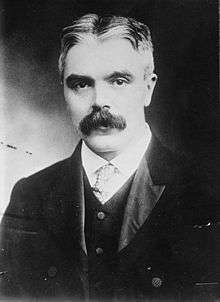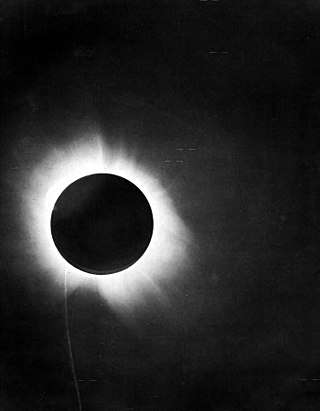Frank Watson Dyson
Sir Frank Watson Dyson, KBE, FRS,[1] FRSE (8 January 1868 – 25 May 1939) was an English astronomer and Astronomer Royal who is remembered today largely for introducing time signals ("pips") from Greenwich, England, and for the role he played in proving Einstein's theory of general relativity.
Sir Frank Watson Dyson | |
|---|---|
 | |
| Born | 8 January 1868 Measham, Leicestershire, England |
| Died | 25 May 1939 (aged 71) At sea |
| Nationality | British |
| Alma mater | Trinity College, Cambridge |
| Known for | Astronomer Royal |
| Awards | Royal Medal (1921) |
| Signature | |
Biography
Dyson was born in Measham, near Ashby-de-la-Zouch, Leicestershire, the son of the Rev Watson Dyson, a Baptist minister, and his wife, Frances Dodwell.[2] They moved to Yorkshire in his youth. There he attended Heath Grammar School, Halifax, and subsequently won scholarships to Bradford Grammar School and Trinity College, Cambridge, where he studied mathematics and astronomy, being placed Second Wrangler in 1889.[3][4][5][6][7]
In 1894 he was given the post of Senior Assistant at Greenwich Observatory and worked on the Astrographic Catalogue, which was published in 1905.[5] He was appointed Astronomer Royal for Scotland from 1905 to 1910, and Astronomer Royal (and Director of the Royal Greenwich Observatory) from 1910 to 1933. In 1928, he introduced in the Observatory a new free-pendulum clock, the most accurate clock available at that time and organised the regular wireless transmission from the GPO wireless station at Rugby of Greenwich Mean Time. He also, in 1924, introduced the distribution of the "six pips" via the BBC. He was for several years President of the British Horological Institute and was awarded their Gold Medal in 1928.[5]
Dyson was noted for his study of solar eclipses and was an authority on the spectrum of the corona and on the chromosphere. He is credited with organising expeditions to observe the 1919 solar eclipse at Brazil and Principe, which he somewhat optimistically began preparing for prior to the Armistice of 11 November 1918. Dyson presented his observations of the solar eclipse of May 29, 1919 to a joint meeting of the Royal Society and Royal Astronomical Society on 6 November 1919. The observations confirmed Albert Einstein's theory of the effect of gravity on light which until that time had been received with some scepticism by the scientific community.[8]
Dyson died on board a ship while travelling from Australia to England in 1939 and was buried at sea.[5]
Honours and awards
- Fellow of the Royal Society – 1901[1]
- Fellow of the Royal Society of Edinburgh – 1906
- President, Royal Astronomical Society – 1911–1913
- Vice-president, Royal Society – 1913–1915
- Knighted – 1915
- President, British Astronomical Association, 1916–1918
- Royal Medal of the Royal Society – 1921
- Bruce Medal of the Astronomical Society of the Pacific – 1922
- Gold Medal of the Royal Astronomical Society – 1925
- Knight Commander of the Order of the British Empire – 1926
- Gold medal of British Horological Institute – 1928
- President of the International Astronomical Union – 1928–1932
- Between 1894–1906, Dyson lived at 6 Vanbrugh Hill, Blackheath, London SE3, in a house now marked by a blue plaque.
- The crater Dyson on the Moon is named after him, as is the asteroid 1241 Dysona.

Family
In 1894 he married Caroline Bisset Best (d.1937), the daughter of Palemon Best, with whom he had two sons and six daughters.
Frank Dyson and Freeman Dyson
Although Frank Dyson and theoretical physicist Freeman Dyson are not known to be related, their fathers Rev Watson Dyson and George Dyson both hailed from West Yorkshire where the surname originates and is most densely clustered.[10] Freeman Dyson credits Sir Frank with sparking his interest in astronomy: because they shared the same last name, Sir Frank's achievements were discussed by Freeman Dyson's family when he was a young boy. Inspired, Dyson's first attempt at writing was a 1931 piece of juvenilia entitled "Sir Phillip Robert's Erolunar Collision" – Sir Philip being a thinly disguised version of Sir Frank.
Selected writings
- Astronomy, Frank Dyson, London, Dent, 1910
See also
References
- Eddington, A. S. (1940). "Sir Frank Watson Dyson. 1868–1939". Obituary Notices of Fellows of the Royal Society. 3 (8): 159–172. doi:10.1098/rsbm.1940.0015.
- Biographical Index of Former Fellows of the Royal Society of Edinburgh 1783–2002 (PDF). The Royal Society of Edinburgh. July 2006. ISBN 0-902-198-84-X.
- "Dyson, Frank Watson (DY886FW)". A Cambridge Alumni Database. University of Cambridge.
- Jackson, John (1940). "Frank Watson Dyson". Monthly Notices of the Royal Astronomical Society. Royal Astronomical Society. 100 (4): 238–246. Bibcode:1940MNRAS.100Q.238.. doi:10.1093/mnras/100.4.238a.
- Spencer Jones, Harold (1939). "Obituary: Sir Frank Watson Dyson". The Observatory. 62 (782): 179–187. Bibcode:1939Obs....62..179S.
- Aitken, Robert Grant (1939). "Sir Frank Watson Dyson, 1868–1939". Publications of the Astronomical Society of the Pacific. Astronomical Society of the Pacific. 51 (304): 336–338. Bibcode:1939PASP...51..336A. doi:10.1086/125099.
- Wilson, Margaret (1951). Ninth Astronomer Royal: The Life of Frank Watson Dyson. Cambridge, England: W. Heffer & Sons Ltd.
- "Joint Eclipse Meeting of the Royal Society and the Royal Astronomical Society". The Observatory: A Monthly Review of Astronomy. 42 (545): 389–398. November 1919. Bibcode:1919Obs....42..389.
- Dyson, F. W.; Eddington, A. S.; Davidson, C. (1920). "A Determination of the Deflection of Light by the Sun's Gravitational Field, from Observations Made at the Total Eclipse of May 29, 1919". Philosophical Transactions of the Royal Society A: Mathematical, Physical and Engineering Sciences. 220 (571–581): 291. Bibcode:1920RSPTA.220..291D. doi:10.1098/rsta.1920.0009.
- Poole, Oliver (9 June 2001). "Why the Dysons keep faith in their genes".
External links
- Online catalogue of Dyson's working papers (part of the Royal Greenwich Observatory Archives held at Cambridge University Library)
- Bruce Medal page
- Awarding of Bruce Medal: PASP 34 (1922) 2
- Awarding of RAS gold medal: MNRAS 85 (1925) 672
- Astronomische Nachrichten 268 (1939) 395/396 (one line)
- Monthly Notices of the Royal Astronomical Society 100 (1940) 238
- The Observatory 62 (1939) 179
- Publications of the Astronomical Society of the Pacific 51 (1939) 336